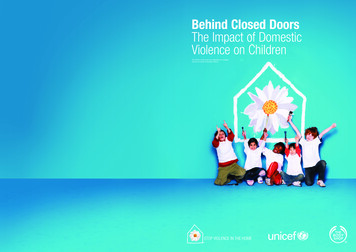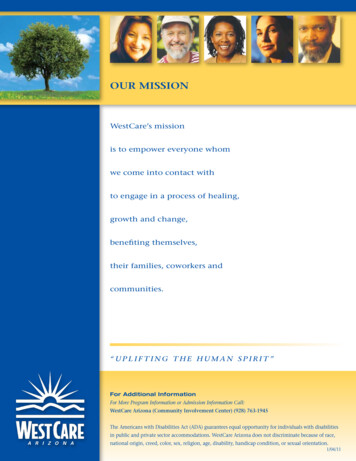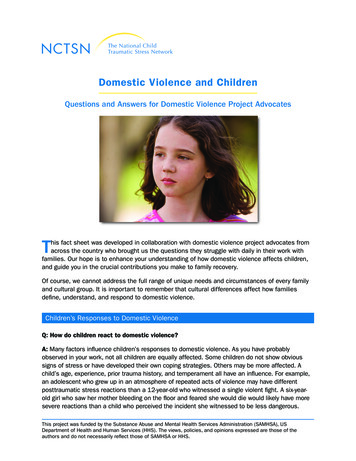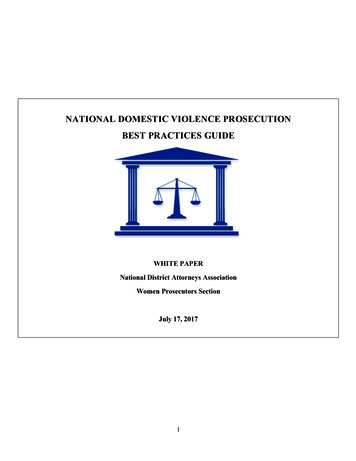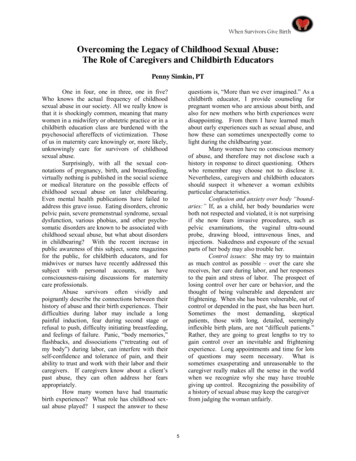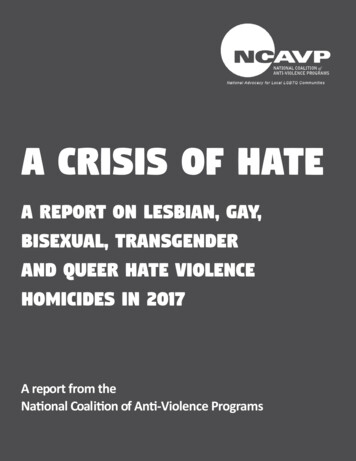
Transcription
Nevada Network Against Domestic ViolenceAdvocating change. Educating our community. Supporting services.Domestic Violence Handbookfor Victims & ProfessionalsThis handbook provides basic information for victims seeking analternative to living in an abusive relationship. It describes the optionsand rights of domestic violence victims, presents the key elements of asafety plan, explains the role of law enforcement and the justice system,Nevada Network AgainstDomestic Violence (NNADV)and provides a list of organizations to contact for emergency services, aswell as general information and assistance.250 South Rock Blvd.Suite 116Reno Nevada 89502Voice/TTY: 775.828.11151.800.230.1955 statewideFunding for the printing, translation anddistribution of this handbook was provided by theState Bar of Nevada’s Lawyer Referral and InformationService (LRIS) Grant Program.Fax: 775.828.9911Website: www.nnadv.orgUpdated 11.19.2012
TABLE OF CONTENTS INTRODUCTION.2 ACKNOWLEDGMENTS .2 FACTS ABOUT DOMESTIC VIOLENCE.3 THE MYTHS AND REALITIES AROUND DOMESTIC VIOLENCE .4 SAFETY PLANNING AND SURVIVAL .5 EMERGENCY ASSISTANCE AND SUPPORT SERVICES .7EMERGENCY SHELTER. 7EMPOWER YOURSELF WITH FINANCIAL ASSISTANCE INFORMATION . 8Welfare, Cash Assistance and Nutrition Services. 8Supplemental Nutrition Assistance Program . 9TANF and the Family Violence Option . 9Child Support Enforcement Program . 11Crime Victim Compensation - Nevada Victims of Crime Program . 12LEGAL SERVICES . 12HOUSING. . 13EMPLOYMENT . 14CONFIDENTIAL ADDRESS PROGRAM (CAP) . 15 THE LEGAL SYSTEM: HOW TO GET HELP .15ORDERS FOR PROTECTION AGAINST DOMESTIC VIOLENCE . 16 STALKING.21 THE LAW ENFORCEMENT PROCESS .21VICTIM INFORMATION AND NOTIFICATION EVERYDAY (VINE). 23 THE CRIMINAL COURT PROCESS .24 CONCLUSION.26 ORGANIZATIONS TO CONTACT FOR INFORMATION, SUPPORT, AND ASSISTANCE.27Funding for the printing, translation and distribution of this handbook was provided by theState Bar of Nevada’s Lawyer Referral and Information Service (LRIS) Grant Program.Page 1
INTRODUCTIONThis handbook is about domestic violence and is written primarily for victims of these types of violence.It is also designed as a useful reference for law enforcement and government officials and professionalsfrom the private sector who assist victims of violence. By communicating and working together, we canprovide more inclusive services and find solutions to this devastating social problem that affects not onlyvictims and their children, but witnesses and bystanders in every community.This handbook provides basic information for victims seeking an alternative to living in an abusiverelationship. It describes the options and rights of victims, presents the key elements of a safety plan,explains the role of law enforcement and the justice system, and provides a list of organizations tocontact for emergency services, as well as general information and assistance.DOMESTIC VIOLENCE is a term that references many types of abuse, such as child abuse, intimatepartner abuse, elder abuse, and sibling abuse. Domestic violence includes acts of physical violence(slapping, punching, strangling, rape, etc.); psychological trauma, threatening, coercive conduct;interference with the personal liberty of the victim; or includes the forcible entry of the victim'sresidence against their will. Domestic violence includes willful conduct intended to harass, such as arson,trespassing, larceny, destruction of private property, carrying a concealed weapon without a permit andstalking. Violence against the victim is often accompanied by emotionally abusive and controllingbehavior, and thus is part of a systematic pattern of dominance and control. It is an epidemic affectingindividuals in every community, regardless of age, economic status, race, religion, nationality, genderidentity, sexual orientation or educational background. The consequences of domestic violence cancross generations and can truly last a lifetime.The information contained in the handbook, is applicable to all victims of domestic violence regardlessof gender or sexual orientation.ACKNOWLEDGMENTSThe Nevada Network Against Domestic Violence (NNADV) wishes to thank the many domestic violenceprofessionals and others in the state of Nevada who have contributed by writing and providingcomments to the production of this valuable resource. Special thanks are directed to Susan Lentz,former Special Projects Assistant, Office of the Attorney General; Kareen Prentice, Domestic ViolenceOmbudsman, Office of the Attorney General; the Honorable Gloria Sanchez, District Court Judge, FamilyDivision of the Eighth Judicial District Court; Elynne Green, Victim Services Supervisor, Las VegasMetropolitan Police Department; Detective Gregory Nauman, Washoe County Sheriff’s Office, Valerie J.Cooney, Esq., Volunteer Attorneys for Rural Nevadans; Judy Buckman, TPO Project in Reno, and LoriFralick, former Domestic Violence Ombudsman, Office of the Attorney General. Staff from the NevadaDepartment of Health and Human Services, Division of Welfare and Supportive Services include:Marybeth Burroughs, Employment and Support Services, David Castagnola and Rose Ramos, ChildSupport Enforcement Unit and Judy Arsiaga, Eligibility and Payments Unit. Overseeing the developmentof this resource was Susan Meuschke, NNADV Executive Director.The original resource is based in part on a handbook developed and published by the Illinois CoalitionAgainst Domestic Violence. This handbook was updated November 19, 2012.Page 2
To obtain printed copies of this handbook, contact the Nevada Network Against Domestic Violence250 South Rock Blvd. Suite 116 Reno NV 89502Voice/TTY: 775.828.1115 1.800.230.1955 statewide Fax: 775.828.9911http://www.nnadv.orgFACTS ON DOMESTIC VIOLENCEThese facts were compiled by the Nevada Network Against Domestic Violence using the followingresources:Domestic Violence Facts National Coalition Against Domestic Violence www.ncadv.org, 2007Get the Facts publications by the Futures Without Violence www.futureswithoutviolence.orgNational Intimate Partner and Sexual Violence Survey (NISVS), National Center for InjuryPrevention and Control, Division of Violence Prevention, Centers for Disease Control andPrevention, www.cdc.gov/violenceprevention/nisvs, 2010United States Department of Justice (DOJ), Bureau of Justice Statistics, National Crime VictimSurvey 2007, 2008 and Family Violence 2005 and other DOJ publications cited.When Men Murder Women: An Analysis of 2010 Homicide Data, Violence Policy Center AnnualReport, September 2012Domestic violence is a major problem in the United States. One in four women while one in sevenmen has been a victim of severe physical violence by an intimate partner at some point in theirlifetime. (NISVS, CDC 2010)Women are much more likely than men to be victimized by a current or former intimate partner.(DOJ 2007-2008). According to reported cases of domestic violence, 84 percent of victims arewomen and about three-fourths of the persons who commit domestic violence are male. (DOJ2005)Women of all ages are at risk for domestic and sexual violence, and those ages 20-24 experiencethe greatest risks of nonfatal intimate partner violence. (Catalano, Shannan DOJ 2007). Youngwomen age 20-24 also experience the highest rates of rape and sexual assault followed by thoseages 16 to 19. (National Crime Victimization Survey, DOJ 2007 2008) People age 18 and 19experience the highest rates of stalking. (Baum, Katrina, et al Stalking Victimization in the UnitedStates, DOJ 2009.)Technology has become a quick and easy way for stalkers to monitor and harass their victims. Morethan one in four stalking victims report that some form of cyberstalking was used against them,such as email (83 percent of all cyberstalking victims) or instant messaging (35 percent). Electronicmonitoring of some kind is used to stalk one in 13 victims. (Ibid.)A recent study found that 44 percent of victims of domestic violence talked to someone about theabuse; 37 percent of those women talked to their health care provider. Additionally, in fourdifferent studies, 70-80 percent of the patients studied reported that they would like their healthcare providers to ask them privately about domestic violence. (Futures Without Violence Fact Sheeton Health Care and Domestic Violence, posted 2012) Approximately one in three adolescent girls inPage 3
the United States is a victim of physical, emotional, or verbal abuse from a dating partner – a figurethat far exceeds victimization rates for other types of violence affecting youth. (Davis, Antoinette,MPH. Interpersonal and Physical Dating Violence among Teens. The National Council on Crime andDelinquency Focus 2008.)Almost one-third of female homicide victims that are reported in police records are killed by anintimate partner (FBI Uniform Crime Reports “Crime in the United States, 2000.”) In 70-80 percentof intimate partner homicides, no matter which partner was killed, the man physically abused thewoman before the murder. (Campbell et al, “Assessing Risk Factors for Intimate Partner Homicide.”Intimate Partner Homicide, NIJ Journal, DOJ 2003)According to a study published by the Violence Policy Center in September 2012, Nevada ranked #1of women murdered by men for a third year in a row. Nevada has held this top spot for five of thelast six years. For additional statistics relating to the incidence of domestic violence and servicesprovided in Nevada, please visit the Nevada Network Against Domestic Violence website atwww.nnadv.org. NNADV compiles statistics submitted by domestic violence community-basedadvocacy programs across Nevada in their quarterly newsletter, The Network News.THE MYTHS AND REALITIES AROUND DOMESTIC VIOLENCEMYTH: A SLAP NEVER HURT ANYONE.REALITY.Physical injuries range from a black eye to broken bones, burst eardrums, split lips, burns,scalds, torn scalps, broken teeth and bruised necks through attempted strangulations. In Nevada (NRS200.481(h), strangulation is defined as intentionally stopping or decreasing normal breathing or bloodflow of another person by putting pressure on the throat or blocking airways, which could result inserious injury or death. Constant exposure to beatings is also damaging mentally in terms of thatindividual's self-esteem, self-worth, and self-confidence.MYTH: ALCOHOL/DRUG ABUSE CAUSES DOMESTIC VIOLENCE.REALITY.Drinking/drug abuse lowers inhibitions or control over violent behavior, but thesesubstances may be used as an excuse to let down these inhibitions.MYTH: DOMESTIC VIOLENCE IS BEHAVIOR THAT IS "OUT OF CONTROL".REALITY.Physical abuse is often the most serious aspect of a course of conduct intended to subjectthe victim to the control of the abuser. Other controlling behaviors may include intimidation, coercionand threats, emotional and economic abuse, using children as weapons, destruction of property andisolation. The abuser's behavior is, therefore, quite intentional.MYTH: I SHOULD STAY WITH MY ABUSER FOR THE SAKE OF THE CHILDREN.REALITY.It is extremely harmful emotionally for children to live in an environment in whichdomestic violence is occurring. This is true even if the child has not been the target of physical abuse,but with early intervention and appropriate referrals, children can be resilient.Page 4
MYTH: ONCE AN ABUSED PERSON, ALWAYS AN ABUSED PERSON.REALITY.There is a growing community awareness of the plight of victims and their children. Thereare counseling programs offering support and help with housing and employment, hotlines providingcrisis counseling and referrals, and shelters providing safe refuge. Victims of abuse can break the cycle ofviolence.SAFETY PLANNING and SURVIVALOnce an abusive act takes place in a relationship, violence almost always reoccurs. In fact, it tends tobecome more severe and more frequent as time goes on. This will happen even when the abuserapologizes and promises to change after an incident. In addition, an abuser will almost always try toisolate the victim by causing disagreements between the victim and those who care about them.Therefore, it is extremely important to think ahead about what to do in the case of another attack. Youmay start by keeping a journal and meeting with a domestic violence advocate to safety plan.WHAT TO DO BEFORE AN ATTACK TO INCREASE SAFETYMAKE CONTACTS.Contact one of the organizations listed at the end of thishandbook to learn about what can be done the next time your partner becomesviolent. These organizations provide information, support, and emergencyassistance. In addition, try to maintain good relationships with friends andrelatives. Their support and assistance will make a difference. Decide now whatto do to protect yourself and your children, where to go and how to get therethe next time violence occurs.BE PREPARED.Prepare for quick access to a phone, cash, clothing, andimportant items such as: house keys, driver’s license, passport, car title and keys,birth certificates, apartment lease, marriage license, school records, medicalcards and records, income and other financial records, all family social security numbers, a list of phonenumbers to call for emergency shelter or transportation, credit cards, blank checks, bank books,medications with a copy of your prescriptions, Order of Protection and immigration papers, if applicableand this handbook.If possible, keep an emergency kit with keys, cash, and essential papers together in a tote bag or othersmall container so that you can easily and quickly grab it and leave. If you are afraid to keep theseessential items together in your home, consider hiding them outside your house or leaving them with atrusted friend. Prepare your children by teaching them their name and address and how to dial 9-1-1 inthe event of an attack.PLAN Plan what to do in dangerous situations. Avoid rooms with weapons, including the kitchen.Practice safety routes and identify a safe place to go and plan how to get there. Discuss your situationwith a domestic violence advocate and if you want, they can assist you with obtaining an Order ofProtection (refer to page 16 for more information). Keep it with you at all times. Trust your instincts; youknow what is best for you.Page 5
CRITICAL STEPS TO TAKE DURING AN ATTACK TO MITIGATE RISKPROTECT YOURSELF AND YOUR CHILDREN.CALL FOR HELP.Scream loudly and continuously. You have nothing to beashamed of. No one deserves to be abused.GET AWAY.When an attack has begun, escape if you can. Whenever youbelieve that you are in danger, leave the location and take your children, nomatter the time of night or day. Go to a safer location such as the house of arelative or friend, or to a public place and call for help.CALL THE POLICE AS SOON AS YOU CAN.Dial 9-1-1. Explain what ishappening or has happened. Tell them where you are. The dispatcher may askquestions. Answer them as clearly as possible. Let the police know whetherthere are weapons or drugs involved. Let them know whether you alreadyhave an Order of Protection against your abuser.KEY STEPS TO TAKE AFTER AN ATTACK TO TAKE CARE OF YOURSELFSEEK MEDICAL ATTENTION IMMEDIATELY.Always seek medical attention. You may be injured moreseriously than you think. Go to your private doctor, a clinic, or an emergency room. Tell the doctor ornurse what happened to you so they can note it in their records. Ask them to take pictures of yourinjuries. Find out how to get copies of your medical records. Inquire about signing a waiver so that theprosecutor or your attorney can obtain copies of those medical records, when necessary.The law prohibits discrimination by your insurance company and they cannot deny your claim or dropyour policy because of domestic violence.SAVE EVIDENCE.As much as you are able, save all evidence showing thatyou were attacked and the seriousness of your injuries. If you did nothave photographs taken while you were receiving medical care, ask afriend, an advocate from the domestic violence program/shelter, or thepolice to take color photographs of your injuries as soon as possible.Additional evidence includes medical records, torn or bloody clothing,weapons, and photographs of the destruction of property, and thedisarray in the house and statements of anyone who heard or saw theattack. The police will also make a report of their investigation. Be sure to include in your statement tothe police the names and addresses of any witnesses. Ask for a copy of the police report.TALK TO SOMEONE ABOUT YOUR OPTIONS.This handbook will give you information about whom tocall for help and information about your options and available services. Ask the advocate questions andtalk to them about your choices. In addition, at the time of a police investigation, peace officers arerequired by law to provide information to domestic abuse victims regarding shelter and othercommunity services, as well as legal options.Page 6
REMEMBER, MOST ABUSERS BECOME MORE VIOLENT.Over time; abusive actions tend to becomemore severe and more frequent. Even though you may be afraid, embarrassed, or even ashamed to actnow, your safety and the safety of your children may depend upon your willingness to take action. Themost dangerous time for a victim of domestic violence is when they are planning to leave therelationship, so it is advised to think carefully, explore all options, and meet with a domestic violenceadvocate to assist you in a safety planning process for you and your children.EMERGENCY ASSISTANCE AND SUPPORT SERVICESThere are people who care that you and your children have been hurt. They have information,experience, and resources to help you plan for a future without violence. The following sections providea general description of the types of agencies and organizations that provide services that you mightneed. There are no miracle answers but together with the appropriate services, you can begin to build abetter future for you and your children.EMERGENCY SHELTERIf you need to get away, try to stay with a friend or a relative. If you cannotfind a safe place to live temporarily, contact the nearest domestic violenceprogram listed at the end of this handbook for more information aboutsheltering services. Shelter can be hard to find, but keep trying and stress tothe people with whom you speak that you are in danger. Apart from shelterservices, information about emergency food, clothing, cash assistance ortransportation is also available at domestic violence programs.If there is no domestic violence program in your area or if they are unable toplace you in shelter, look for social service organizations in your community.You may also be able to receive assistance from local faith-basedorganizations.Even if you do not need or want emergency shelter assistance, talking with other people who have beenabused, or with a peer counselor, can help you learn about the alternatives available to you. Knowingthat you are not alone may help you break the cycle of violence. You will not be told what to do; rather,you will receive information and support so that you can make the best possible decisions for yourselfand your children.The more you talk about your situation with trusted friends or relatives, the better able you will be tofigure out what you want to do. If you keep it all a secret, you are protecting the abuser, not yourselfand your children. Sharing your experiences with other people who have had similar experiences can bea great help. If there are no victim support groups in your area, talk to the advocates from the localdomestic violence program or mental health agency about starting a group. The more you explore yourlife circumstances, the more you will discover new possibilities for a violence-free future.Page 7
EMPOWER YOURSELF WITH FINANCIAL ASSISTANCEINFORMATIONVictims often feel they are trapped in abusive relationships because of financialreasons. Often, abusers will repeatedly tell their victims they will never be ableto be hired or hold a job. There are no easy answers, but the informationcontained in this section may provide the first steps in achieving independencefrom your abuser.Welfare, Cash Assistance, and Nutrition ServicesThe Nevada Division of Welfare and Supportive Services, Nevada Department of Health and HumanServices, provides temporary services to Nevada families, the disabled and elderly to achieve selfsufficiency.Whether or not you are working, you may be eligible for cash assistance or other aid from County andState agencies. Support services are discussed below.County Social Services: The social services agency in your county may have cash assistance or otherlocal aid programs. Contact them for information on how to apply for assistance that may be availableto you.Nevada Division of Welfare and Supportive Services: The Nevada Division of Welfare and SupportiveServices administers the federally funded block grant from the Department of Health and HumanServices called Temporary Assistance for Needy Families (TANF). TANF provides temporary assistancefor the care of dependent children in their own homes or the homes of relatives by furnishing financialassistance enabling Nevada families to achieve their highest levels of self-sufficiency. Accepting TANFsubjects the household to federal and state time limits to receive financial assistance. A household inwhich any adult member (this includes a minor parent who is/was the head of household) regardless ofwhether those months are consecutive or cumulative, received TANF benefits from Nevada or anyother state for 60 months, is prohibited from receiving TANF cash benefits.Since Nevada limits TANF benefits to 24 months regardless of whether those months are consecutive orcumulative; the household is prohibited from receiving additional benefits for 12 consecutive months.After not receiving benefits for 12 months, the household may apply for TANF for an additional 24months at which time financial benefits will end for 12 months. After not receiving benefits for 12months, the household can apply for benefits for the final 12 months. For either Federal or Nevadareceipt of benefit limitations, the continuation of benefits due to a viable “hardship” may beconsidered.“Assistance” is defined as cash payments, vouchers and other benefitsprovided to meet a family’s ongoing basic needs such as food, shelter,clothing, etc. It may include child care, transportation and othersupport services for families that are not employed.Page 8
Supplemental Nutrition Assistance Program (SNAP)Many Nevadans have trouble making ends meet each month. After paying for rent, utilities,transportation, and child care, there is often little left to buy nutritious food, but it doesn’t have to bethat way. Each month, thousands of families across the state turn to the Nevada State Division ofWelfare and Supportive Services for assistance in the form of SNAP benefits to help feed their families.You may be eligible to receive SNAP benefits if you:Work for low wages;Are unemployed or work part time;Receive welfare or other public assistance payments;Are elderly or disabled and live on a small income; orAre homeless.When meeting with your Division case manager, ask about food and nutrition services that are availablelocally and federal assistance programs.TANF and the Family Violence OptionThe Family Violence Option (FVO) was adopted by the Nevada Division of Welfare and SupportiveServices after research showed that some TANF requirements would endanger some families, and thatdomestic violence is a major barrier to self-sufficiency.The Family Violence Option commits the Nevada Division of Welfare and Supportive Services to: 1)screen for domestic violence among TANF participants; 2) make referrals to counseling and supportiveservices; and 3) after participating in an individualized assessment which has identified specific needs,the client may have “good cause” to be excused from TANF program requirements. You can file anapplication from the domestic violence program that often acts as your authorized representative.Federal and state regulations prohibit the disclosure of information pertaining to you and yourchild(ren). All information is confidential and your location will not be released. However, you must stillmeet financial and non-financial requirements (e.g., income and resource limits, residency). Workrequirements mandated by NEON, eligibility requirements to establish cash benefits and cooperationwith the Child Support Enforcement Program (CSEP) as well as related court appearances may bewaived once “good cause” has been granted. CSEP will be discussed later in this section.How do I apply for services?You can apply online: ACCESS NEVADA English or ACCESS NEVADA en Español or you can visit the localwelfare office to pick up or file an application; or request an application be mailed to you. Theapplication may be mailed, dropped off or faxed to your local welfare office and is used to apply for anyand all programs on the form. For a list of welfare offices in Nevada, visit the Division of Welfare andSupportive Services website https://dwss.nv.gov and click on the contact us link.If you are receiving services from a domestic violence program in Nevada, your application can be filedfrom the program which often acts as your authorized representative. Federal and state regulationsprohibit the disclosure of information pertaining to you and your children. All information is confidentialand your location will not be revealed. You must still meet financial and nonfinancial requirements (e.g.,income and resource limits, residency.) If you meet these requirements, cooperation with the ChildPage 9
Support Enforcement Program (CSEP) and related court appearances will be waived. The NevadaDivision of Welfare and Supportive Services is required to verify information you provide on theApplication for Assistance. To receive TANF benefits, a face-to-face interview is required. In preparationfor your interview, collect and bring with you documentation that will provide verification in order toprevent delays in processing your application for assistance. In addition, you will be asked to agree tospecific eligibility criteria.The criteria for eligibility is listed and explained on the Nevada Division of Welfare and SupportiveServices website https://dwss.nv.gov. The most common areas needing verification are:Proof of Residency – Applicants must be living in the state with the intention of making Nevadatheir home permanently, or for an indefinite period, or entering Nevada with a job commitmentor seeking employment. Proof may include a lease agreement, rent receipt, mortgage, or utilitybills.Identification – Nevada driver’s license or other identification (ID), social security card or proofyou have applied for one, proof of birth for all persons applying for assistance, marriage ordivorce decree, proof of school attendance for school-aged children.Proof of Citizenship All persons applying for or receiving TANF and/or Medicaid must providesatisfactory evidence of citizenship or nationality and identity for all household members.Proof of Income Received – It is important to bring along verification of items including yourmonthly income (pay stubs or statement from your employer), social security benefits, childsupport payments, loans, etc. You will also be asked to bring your latest bank statements andproof of other assets such as vehicles and/or property.Verification of Household Composition – Who lives in the house and what is their relationship tothe children? If providing the requested information would threaten the safety
crisis counseling and referrals, and shelters providing safe refuge. Victims of abuse can break the cycle of violence. SAFETY PLANNING and SURVIVAL Once an abusive act takes place in a relationship, violence almost always reoccurs. In fact, it tends to become more severe and more frequent as time goes on.
